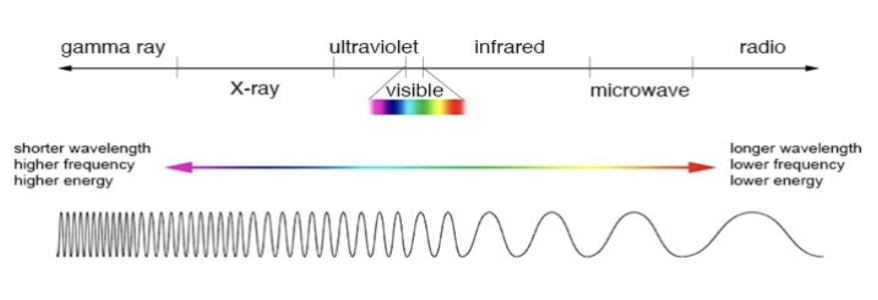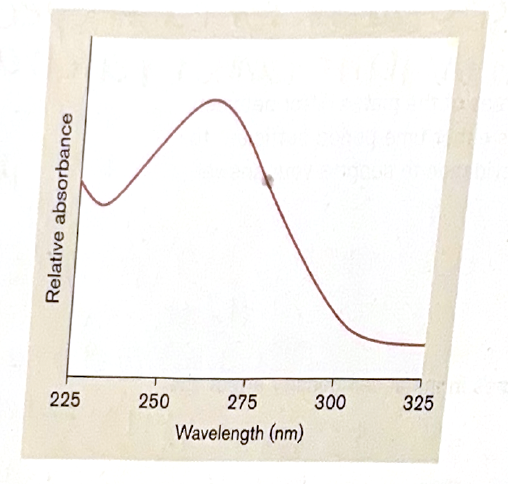Lab 16: Ultraviolet Light
1/14
There's no tags or description
Looks like no tags are added yet.
Name | Mastery | Learn | Test | Matching | Spaced |
|---|
No study sessions yet.
15 Terms
ultraviolet light (UV)
is part of the electromagnetic spectrum
UV light includes wavelengths of light between 200-400nm

UV light has significant effect on cells — DNA absorbs the energy in UV light at 256nm. What effect does it have”?
leads to formation of pyrimidine dimers (covalent links between thymine)
prevent accurate DNA replication — too many mutations cause cell death
bacteria are susceptible to UV damage due to “compact” genomes
“killing power” varies depending on…
the wavelength 260nm-265nm will kill bacteria (most germicidal)
time of exposure
distance between light source and the cells
type of organism: spores are more resistant to UV rays
presence of UV-blocking or UV-absorbing pigments
repair system
what are repair systems?
can prevent fatal accumulations of mutations
photoreactivation
dark repair
photoreactivation
enzymes activated by light can cleave thymine dimers to restore DNA
dark repair
thymine dimer found can be removed and replaced with a new thymine base
UV is often used to _________ ________ of lab hoods
disinfect surfaces
limited by poor penetrating power as it _______________________ and can be dangerous to human “increases the risk of skin cancer”
can be blocked by plastic
how did covering or shading part of the agar surface with a petri dish lid alter the amount of bacterial growth on the plates? what do these results tell you about the ability of 254nm of UV light to penetrate clear plastics that are transparent to visible light?
looking at our pooled results as a class, each species showed less growth in the unshaded region exposed to UV light compared to the unshaded region (look at 180s column for each specie). These results tell us that 254nm UV light cannot penetrate clear plastic as the shaded regions always produced higher growth.
how did the amount of growth on the unshaded areas of the plate differ between the 30 seconds and 180 seconds plates? was either time period sufficient to sterilize the unshaded surface of the agar?
for the 30 second unshaded areas, there was not a huge change in growth compared to the shaded region, meaning 30 seconds was not enough time to sterilize the agar. For 180s seconds unshaded areas there was a much more noticeable change in growth for the shaded vs. unshaded region, meaning 180 seconds is more effective at sterilizing the agar.
how might differences among the stock cultures in initial cell density affect the outcome of this experiment?
differences in initial cell density of these stock cultures could affect the outcome of this experiment because it can influence growth rate, nutrient availability, experiment variability, and cell-to-cell interactions.
which species (e.coli, m.luteus, b.megaterium) produced the least growth in the unshaded areas after 180 seconds of UV exposure? give 2 possible reasons or explanations for why that species (instead of the others) produced the least growth.
m.luteus produced the least growth in the unshaded area after 180 seconds of UV exposure with a mean score of 0.4. This species produced the least growth because it could be more susceptible to UV damage compared to other species or it could have inefficient DNA repair mechanisms that are not good at recovering from UV damage
which species (e.coli, m.luteus, b.megaterium) produced the most growth in the unshaded areas after 180 seconds of UV exposure? give 2 possible reasons or explanations for why that species (instead of the others) produced the least growth.
b. megaterium produced the most growth in the unshaded areas after 180 seconds of UV exposure with a mean score of 3. This species produced the most growth because it could be more efficient at repairing DNA from UV damage or since it produces endospores, it might require more wavelengths of UV in order to damage/kill the cells
was the answer to the question above (which species produced the most growth) what you expected? why or why not?
yes, this is what I expected because b. megaterium is able to form endospores, which have a significant effect on it’s ability to survive exposure to UV light. Endospores can withstands harsh environment conditions like UV exposure.

the figure below shows the absorption by double-stranded DNA of a range of UV light wavelengths. Now assume that the only UV lamp that you have available for the control of microbes emits light with a wavelength of 275nm
a. how would the rate of the mutation generated by exposure to 275nm light compare with that produced by exposure to 255nm light (the approximate wavelength used in this lab)?
b. how would the rate at which the bacterial cells die be changed by the use of 275nm light instead of 255nm light?
c. if your goal was to kill a given number of cells, how would you alter or adjust the time of exposure at 275nm compared with 255nm?
a. the relative absorbance of UV radiation is higher at 255nm compared to 275nm. Therefore, the rate of mutations is higher at 255nm than 275nm
b. due to rate of mutation being higher at 255nm compared to 275nm, the rate at which bacterial cells die will be lower at 275nm compared to 255nm
c. the rate of mutation is higher at 255nm compared to 275nm, so it would take less time to kill bacterial cells at 255nm. For 275nm, the time of exposure must be longer than time exposed at 255nm